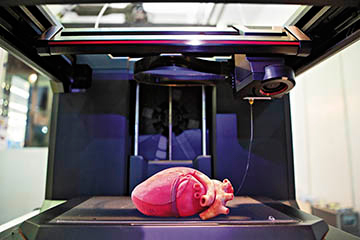By Dr. Brit Cooper-Jones
There may be many people who have heard of 3-D printing and/or bioprinting – but for others, these may be new concepts. Yet there is thought that they could change the field of health care in substantial ways in years to come.
To start off with, what exactly is 3-D printing? Or bioprinting, for that matter?
3-D printing is defined as an additive manufacturing process – that is, a process by which 3-D objects are created, layer by layer, from raw materials guided by a digital file. Put simply – and applied to a health care context – this could mean “printing” a wide range of 3-D objects, including anatomic models to aid in visualizing and planning complex surgical interventions, custom tools and guides for surgery, personalized or patient-specific medical devices at the point-of-care, devices or supplies on-site as needed, 3-D printed drug delivery systems, and much more.
Bioprinting is a technique that combines living cells (e.g., stem cells) and supportive biomaterials (e.g., scaffolds on which cells can grow) into “bioinks,” which are then printed into pre-specified, computer-generated designs, with the goal of having these cells eventually mature to form specific tissues. One of the objectives of bioprinting research and design (and of the field of regenerative medicine more broadly) is to potentially one day be able to generate full organs for transplant, though this is still in early stages.
So how might 3-D printing and/or bioprinting impact actual patient care in the immediate or near future? To gain a greater understanding of the current state of the research, CADTH conducted a Horizon Scan that looked at current and emerging uses of 3-D printing and bioprinting that have the potential to impact health care. CADTH is an independent agency that finds, assesses, and summarizes the research on drugs, medical devices, tests, and procedures to find out what the evidence says. CADTH’s report An Overview of Clinical Applications of 3-D Printing and Bioprinting provides a synopsis of emerging innovations of this type across a variety of specialty areas and stages of development.
The clinical areas where the research on 3-D printing has advanced the furthest are dentistry and oral and maxillofacial surgery, as well as orthopedics and the musculoskeletal system. For example, studies have reported improvements in surgical accuracy and decreases in operating time with the use of surgical guides and 3-D models to help with anatomic visualization. There is also the possibility of creating dental and surgical devices via 3-D printing, such as orthodontic devices, dental crowns, dentures, and implants for orthopedic arthroplasty. And these are only some of the potential applications of 3-D printing in these fields.
Overall, however, the evidence is still limited for direct patient-specific outcomes and longer-term outcomes. In addition, little is known about the cost-effectiveness of various 3-D printing innovations compared with the current standard of care. These factors, in addition to regulatory, technical, other considerations, will all need to be taken into account before 3-D printing is adopted more widely into routine clinical practice.
Another potential application of 3-D printing in health care is to create custom medical devices such as prosthetics and orthotics. In theory, these devices could be uniquely tailored to each patient, accounting for individual variances and thus offering a form of personalized medicine. However, the types of study designs that would be best suited to evaluate customized devices, as well as regulatory concerns with the potential shift to a decentralized manufacturing process (i.e., at the hospital or clinic level), are only some of the additional factors that will need to be considered as the research continues to move forward.
With regard to bioprinting, the current research is still in the early stages, consisting primarily of in vitro experimentation and conceptual exploration. However, there is hope of one day using bioprinting to generate full organs, help with joint repair and replacement surgeries, and move away from animal testing (and toward testing with 3-D cell cultures instead), to give some examples.
In closing, the fields of 3-D printing and bioprinting are exciting and highly active areas of research, with the potential to transform the delivery of health care in years to come. At the time of CADTH’s Horizon Scan, over 100 clinical trials of clinical applications of 3-D printing were registered as in progress or recruiting in the International Clinical Trials Registry Platform and ClinicalTrials.gov.
Looking beyond the current state of 3-D printing, 4-D printing – an approach that adds a dimension of transformation or adaptation of the device over time in response to specific parameters – may offer additional advantages in the medical field as smart implants, tools, and devices become more common.
If you’d like to learn more about CADTH or this Horizon Scan, visit www.cadth.ca. You can also follow us on Twitter @CADTH_ACMTS or speak to a CADTH Liaison Officer in your region.
Dr. Brit Cooper-Jones, MD is a Knowledge Mobilization Officer at CADTH.


